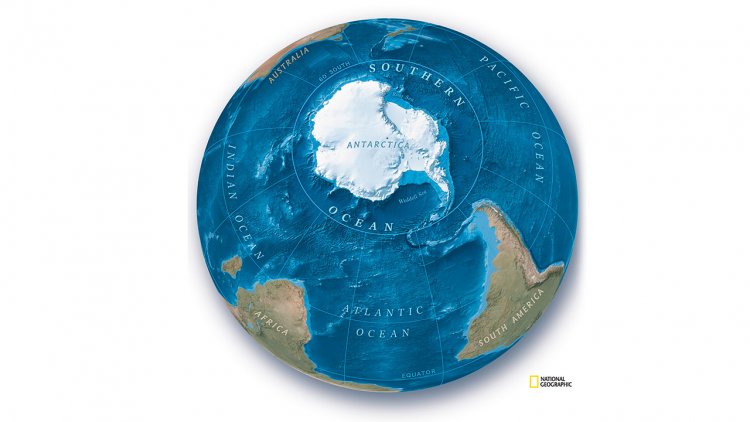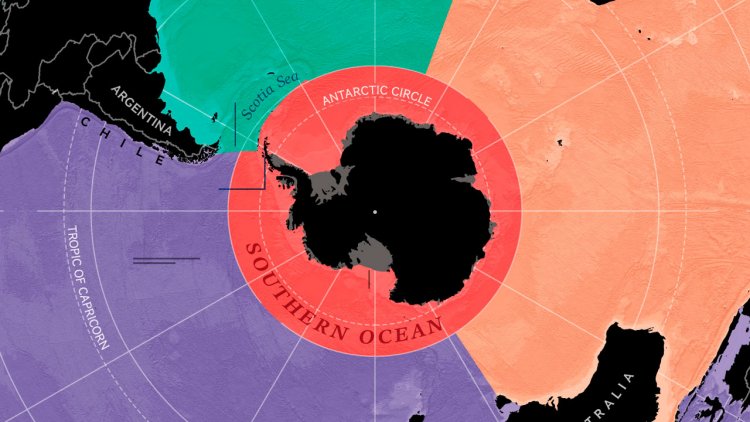National Geographic recognizes Southern Ocean as Earth's 5th ocean
Nat Geo cartographers say the swift current circling Antarctica keeps the waters there distinct and worthy of their own name: the Southern Ocean.

Those familiar with the Southern Ocean, the body of water encircling Antarctica, know it’s unlike any other.
Seth Sykora-Bodie, a marine scientist at the National Oceanic and Atmospheric Administration (NOAA) and a National Geographic Explorer, says:
“Anyone who has been there will struggle to explain what's so mesmerizing about it, but they'll all agree that the glaciers are bluer, the air colder, the mountains more intimidating, and the landscapes more captivating than anywhere else you can go.”
Since National Geographic began making maps in 1915, it has recognized four oceans: the Atlantic, Pacific, Indian, and Arctic Oceans. Starting on June 8, World Oceans Day, it will recognize the Southern Ocean as the world’s fifth ocean.
National Geographic Society Geographer Alex Tait says:
“The Southern Ocean has long been recognized by scientists, but because there was never agreement internationally, we never officially recognized it.”
Geographers debated whether the waters around Antarctica had enough unique characteristics to deserve their own name, or whether they were simply cold, southern extensions of the Pacific, Atlantic, and Indian Oceans.
The change, Tait adds, aligns with the Society’s initiative to conserve the world’s oceans, focusing public awareness onto a region in particular need of a conservation spotlight.
Tait says:
“We’ve always labeled it, but we labeled it slightly differently [than other oceans]. This change was taking the last step and saying we want to recognize it because of its ecological separation.”
While the other oceans are defined by the continents that fence them in, the Southern Ocean is defined by a current.

Scientists estimate that the Antarctic Circumpolar Current (ACC) was established roughly 34 million years ago, when Antarctica separated from South America. That allowed for the unimpeded flow of water around the bottom of the Earth.
The ACC flows from west to east around Antarctica, in a broad fluctuating band roughly centered around a latitude of 60 degrees south—the line that is now defined as the northern boundary of the Southern Ocean. Inside the ACC, the waters are colder and slightly less salty than ocean waters to the north.
Extending from the surface to the ocean floor, the ACC transports more water than any other ocean current. It pulls in waters from the Atlantic, Pacific, and Indian Oceans, helping drive a global circulation system known as the conveyor belt, which transports heat around the planet. Cold, dense water that sinks to the ocean floor off Antarctica also helps store carbon in the deep ocean. In both those ways, the Southern Ocean has a crucial impact on Earth’s climate.
Scientists are currently studying how human-driven climate change is altering the Southern Ocean. Ocean water moving through the ACC is warming, scientists have learned, but it’s unclear how much this is impacting Antarctica. Some of the most rapid melting of the continents ice sheets and shelves have been where the ACC is closest to land.
For now, by fencing in the frigid southern waters, the ACC helps keep Antarctica cold and the Southern Ocean ecologically distinct. Thousands of species live there and nowhere else.
The Southern Ocean has ecological effects elsewhere as well. Humpback whales, for example, feed on krill off Antarctica and migrate far north to winter in very different ecosystems off South and Central America. Some seabirds migrate in and out too.
By drawing attention to the Southern Ocean, the National Geographic Society hopes to promote its conservation.

























































































































































